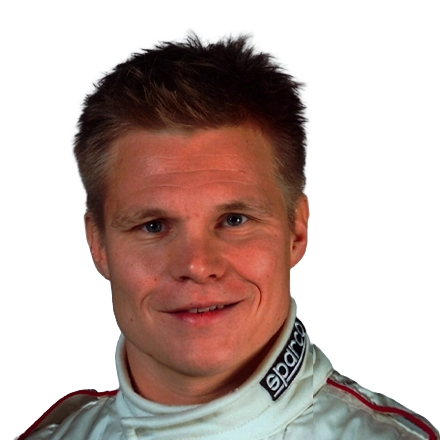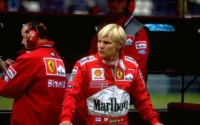Mika Salo could have easily been forgotten among the two Mikas after a hard-fought British Formula 3 championship in 1990, where he closely contested the title against his rival Mika Hakkinen. While the champion was signed by Lotus, Salo, despite his six wins, lacked sufficient backing to secure a ride in European F3000. It must have been disheartening for Salo, who had an impressive track record in karts and FF1600 in Scandinavia. Fortunately, he found a lifeline in Japan, testing and racing for Yokohama. Although his performance in the All-Japan F3000 championship wasn’t spectacular, his four-year stint in the Far East gave him substantial experience.
| Nationality | Finnish |
|---|---|
| Born | Mika Juhani Salo 30 November 1966 Helsinki, Finland |
This experience paid off when he drove for Lotus in the 1994 Japanese Grand Prix, where he shone in poor weather conditions, finishing tenth without making any errors. This performance revived his career, and when Lotus closed its doors, Salo joined Tyrrell for the 1995 season. He made a sensational debut in Brazil, nearly earning points but for a bout of cramp, and generally outperformed his teammate Ukyo Katayama throughout the season. Despite rough edges and questionable tactics, he managed three points-scoring finishes in the last six races.
Salo had the speed to climb higher in the Grand Prix ranks, but the 1996 season was challenging due to the fragility of the Yamaha engine. Locked into a three-year deal with Tyrrell, he was joined by Jos Verstappen in 1997. Although they had more reliable Ford engines, they lacked straight-line speed. Salo seized a chance to score points at Monaco, driving a brilliant non-stop race to finish fifth, highlighting his underutilised talent.
In 1998, Salo moved to Arrows to replace Damon Hill, finding himself in a similar situation with reliable but slow machinery. He managed a fourth-place finish at the 1998 Monaco Grand Prix but no other top-six finishes. When Pedro Diniz moved to Sauber with his sponsorship, Salo was replaced by Pedro de la Rosa and Toranosuke Takagi, both backed by substantial sponsorships. This turned out to be a blessing in disguise as Salo replaced Ricardo Zonta at BAR after Zonta’s injury. He finished one of his three races before stepping down, only to be quickly called back by Ferrari where he stood in for six races in 1999 due to the injured Michael Schumacher.
This was Salo’s big chance, and he made a significant impression at the 1999 German Grand Prix, controlling the race before moving aside to let teammate Eddie Irvine win in his championship quest. Salo scored two podiums and contributed to Ferrari winning the 1999 Constructors’ Championship. His drive helped to secure a seat at Sauber for 2000, but he left after one season to help prepare the new Toyota F1 team, which would eventually debut on the grid in 2002.
He scored two points for Toyota in their debut season, becoming the first driver since JJ Lehto at the 1993 South African Grand Prix to score points in a team’s first race by finishing sixth at the 2002 Australian Grand Prix. He retired from Formula 1 at the end of 2002 after being fired by Toyota. Initially, the news was met with surprise, but it was later revealed that Salo had a strained relationship with the team, who criticised his performance as subpar.
During his Formula 1 career, Salo achieved two podiums and scored 33 championship points. Beyond F1, he went on to win the GT2 class in the 2008 and 2009 24 Hours of Le Mans.
Mika Salo Formula One World Championship career
| F1 Career | 1994–2000, 2002 |
|---|---|
| Teams | Lotus, Tyrrell, Arrows, BAR, Ferrari, Sauber, Toyota |
| Entries | 111 (109 starts) |
| Championships | 0 |
| Wins | 0 |
| Podiums | 2 |
| Career points | 33 |
| Pole positions | 0 |
| Fastest laps | 0 |
| First entry | 1994 Japanese Grand Prix |
| Last entry | 2002 Japanese Grand Prix |
Mika Salo Teammates
| 8 drivers | Involvement | First Year | Last Year |
|---|---|---|---|
| Alex Zanardi | 2 | 1994 | |
| Ukyo Katayama | 32 | 1995 | 1996 |
| Gabriele Tarquini | 1 | 1995 | |
| Jos Verstappen | 17 | 1997 | |
| Pedro Diniz | 33 | 1998 | 2000 |
| Jacques Villeneuve | 3 | 1999 | |
| Eddie Irvine | 6 | 1999 | |
| Allan McNish | 17 | 2002 |
Complete Formula One Results
| Year | Entrant | Chassis | Engine | 1 | 2 | 3 | 4 | 5 | 6 | 7 | 8 | 9 | 10 | 11 | 12 | 13 | 14 | 15 | 16 | 17 | WDC | Points |
|---|---|---|---|---|---|---|---|---|---|---|---|---|---|---|---|---|---|---|---|---|---|---|
| 1994 | Team Lotus | Lotus 109 | Mugen Honda V10 | BRA | PAC | SMR | MON | ESP | CAN | FRA | GBR | GER | HUN | BEL | ITA | POR | EUR | JPN 10 | AUS Ret | NC | 0 | |
| 1995 | Nokia Tyrrell Yamaha | Tyrrell 023 | Yamaha V10 | BRA 7 | ARG Ret | SMR Ret | ESP 10 | MON Ret | CAN 7 | FRA 15 | GBR 8 | GER Ret | HUN Ret | BEL 8 | ITA 5 | POR 13 | EUR 10 | PAC 12 | JPN 6 | AUS 5 | 15th | 5 |
| 1996 | Tyrrell Yamaha | Tyrrell 024 | Yamaha V10 | AUS 6 | BRA 5 | ARG Ret | EUR DSQ | SMR Ret | MON 5 † | ESP DSQ | CAN Ret | FRA 10 | GBR 7 | GER 9 | HUN Ret | BEL 7 | ITA Ret | POR 11 | JPN Ret | 13th | 5 | |
| 1997 | PIAA Tyrrell Ford | Tyrrell 025 | Ford V8 | AUS Ret | BRA 13 | ARG 8 | SMR 9 | MON 5 | ESP Ret | CAN Ret | FRA Ret | GBR Ret | GER Ret | HUN 13 | BEL 11 | ITA Ret | AUT Ret | LUX 10 | JPN Ret | EUR 12 | 17th | 2 |
| 1998 | Danka Zepter Arrows | Arrows A19 | Arrows V10 | AUS Ret | BRA Ret | ARG Ret | SMR 9 | ESP Ret | MON 4 | CAN Ret | FRA 13 | GBR Ret | AUT Ret | GER 14 | HUN Ret | BEL DNS | ITA Ret | LUX 14 | JPN Ret | 13th | 3 | |
| 1999 | British American Racing | BAR 01 | Supertec V10 | AUS | BRA | SMR 7 † | MON Ret | ESP 8 | CAN | FRA | GBR | 10th | 10 | |||||||||
| Scuderia Ferrari Marlboro | Ferrari F399 | Ferrari V10 | AUT 9 | GER 2 | HUN 12 | BEL 7 | ITA 3 | EUR Ret | MAL | JPN | ||||||||||||
| 2000 | Red Bull Sauber Petronas | Sauber C19 | Petronas V10 | AUS DSQ | BRA DNS | SMR 6 | GBR 8 | ESP 7 | EUR Ret | MON 5 | CAN Ret | FRA 10 | AUT 6 | GER 5 | HUN 10 | BEL 9 | ITA 7 | USA Ret | JPN 10 | MAL 8 | 11th | 6 |
| 2002 | Panasonic Toyota Racing | Toyota TF102 | Toyota V10 | AUS 6 | MAL 12 | BRA 6 | SMR Ret | ESP 9 | AUT 8 | MON Ret | CAN Ret | EUR Ret | GBR Ret | FRA Ret | GER 9 | HUN 15 | BEL 7 | ITA 11 | USA 14 | JPN 8 | 17th | 2 |
Sources: Historicracing.com and Wikipedia.com









